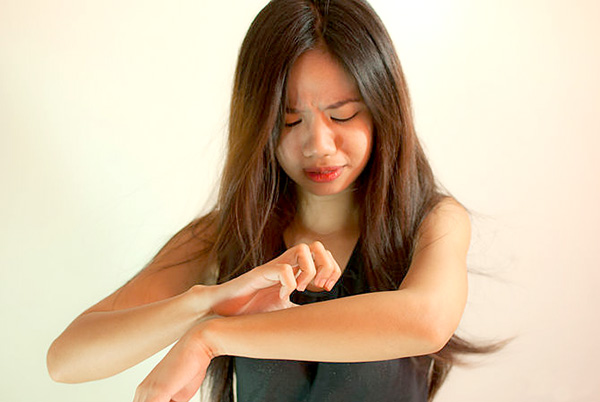Most common areas where the rash can occur in adults are front, back, palms and foot.
In children the location may be different, such as face and scalp.
Characteristic lesion for scabies is the mite ditch that is a tortuous course and corresponds to the path carved by the female.
Other skin lesions: papulopustular impetigo blisters, blisters pearl, scratching lesions (arising as a result of scratching), palmar- planted vesiculobullous bubbles (children only), crusted skin, ulcerated areas.
Describing the various forms of scabies:
– Classical: scratching lesions, pearl vesicles;
– Incognita: to those who were treated with cortisone, the signs appears atypical and different from the classical type;
– Attenuated form: occurs in people with a good hygiene which shows a little itching and smaller skin lesions;
– Nodular: occurs after administration of fluorinated steroids, with the development of red-brown nodules;
– Norwegian: occurs in immunosuppressed patients with neurological or endocrinological diseases, or in people incorrectly treated with corticosteroids. The disease develops thick scales that extend over large areas of the body and are difficult to treat;
– Immune persons: showing minimal symptoms and may heal spontaneously.
Diagnosis of scabies:
It is necessary to contact a doctor if you experience any of the symptoms of scabies. This can lead to the correct diagnosis and treatment, shortening the duration of the disease evolution and minimizing the discomfort.
Diagnosis is made by:
– Clinical examination: the doctor will closely examine skin lesions and may determine a proper diagnosis;
– Examination with a magnifying glass: which will highlight Sarcoptes Scabies mites and ditches;
– Microscopic examination: a piece of affected skin is examined for the existence of microscopic eggs, larvae or adults;
– Ink test: This allows viewing mite trench using ink drip over the affected areas.
Treatment of scabies (local or general):
Local treatment can be done with:
– Permethrin 5%
– Lindane 1%
– 25-35 % benzyl benzoate
– Crotamiton 10%
– Malathion 0-5 %
– Anti-itching cream
– Sulphur 5-10 %
– Corticosteroids, liquid nitrogen: if nodular scabies
For general treatment are used:
– Antihistamines: used to reduce itching;
– Antibiotics: when overgrowth is present.
The lesions start to involution 1-2 days after starting the treatment; patient becomes non-contagious after only 24 hours.
Complications of scabies:
The most common complications are:
– Superinfection with streptococci or staphylococci
– Pyoderma
– Itching, post-scabies
– Folliculitis
Important!
– It is very important to boil the sheets to prevent contamination of other persons;
– Since scabies is a contagious and commonly disease, and several members of a family or community can be affected, it is important that everyone who came into contact with the affected person to be treated;
– Using appropriate hygiene;
– Do not hesitate to go to the doctor to get proper treatment and avoid contaminating others.
